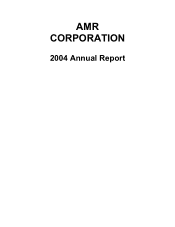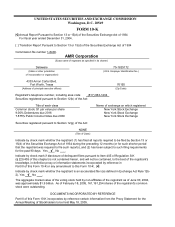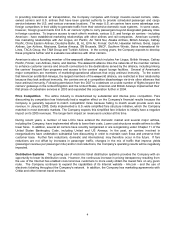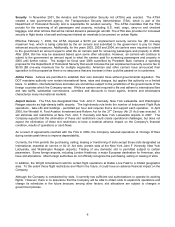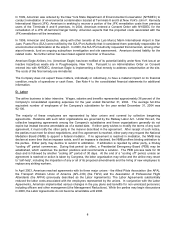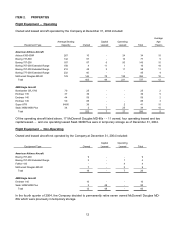American Airlines 2004 Annual Report Download - page 7
Download and view the complete annual report
Please find page 7 of the 2004 American Airlines annual report below. You can navigate through the pages in the report by either clicking on the pages listed below, or by using the keyword search tool below to find specific information within the annual report.4
In providing international air transportation, the Company competes with foreign investor-owned carriers, state-
owned carriers and U.S. airlines that have been granted authority to provide scheduled passenger and cargo
service between the U.S. and various overseas locations. The major U.S. air carriers have some advantage over
foreign competitors in their ability to generate traffic from their extensive domestic route systems. In some cases,
however, foreign governments limit U.S. air carriers' rights to carry passengers beyond designated gateway cities
in foreign countries. To improve access to each other's markets, various U.S. and foreign air carriers - including
American - have established marketing relationships with other airlines and rail companies. American currently
has marketing relationships with Aer Lingus, Air Pacific, Air Tahiti Nui, Alaska Airlines, British Airways, Cathay
Pacific, China Eastern Airlines, Deutsche Bahn, EL AL, EVA Air, Finnair, Gulf Air, Hawaiian Airlines, Iberia, Japan
Airlines, Lan Airlines, Mexicana, Qantas Airways, SN Brussels, SNCF, Southern Winds, Swiss International Air
Lines, TACA Group, the TAM Group and Turkish Airlines. In the coming years, the Company expects to develop
these programs further and to evaluate new alliances with other carriers.
American is also a founding member of the oneworld alliance, which includes Aer Lingus, British Airways, Cathay
Pacific, Finnair, Lan Airlines, Iberia, and Qantas. The oneworld alliance links the networks of the member carriers
to enhance customer service and smooth connections to the destinations served by the alliance, including linking
the carriers' frequent flyer programs and access to the carriers' airport lounge facilities. Several of American's
major competitors are members of marketing/operational alliances that enjoy antitrust immunity. To the extent
that American and British Airways, the largest members of the oneworld alliance, are restricted in their relationship
because they lack antitrust immunity, the carriers are at a competitive disadvantage vis-à-vis other alliances that
have antitrust immunity. Following permission from the DOT to codeshare on a wide number of flights beyond the
carriers’ gateways in the United Kingdom and the United States, American and British Airways implemented their
first phase of codeshare services in 2003 and expanded this cooperation further in 2004.
Price Competition The airline industry is characterized by substantial and intense price competition. Fare
discounting by competitors has historically had a negative effect on the Company’s financial results because the
Company is generally required to match competitors' fares because failing to match would provide even less
revenue. In January 2005, Delta implemented a U.S.-wide simplified fare structure initiative, which the Company
matched in most domestic markets. The Company expects this simplified fare initiative to initially have a negative
impact on its 2005 revenues. The longer-term impact on revenues is unclear at this time.
During recent years, a number of new LCCs have entered the domestic market and several major airlines,
including the Company, have implemented efforts to lower their costs. Lower cost structures enable airlines to offer
lower fares. In addition, several air carriers have recently reorganized or are reorganizing under Chapter 11 of the
United States Bankruptcy Code, including United and US Airways. In the past, air carriers involved in
reorganizations have undertaken substantial fare discounting in order to maintain cash flows and preserve their
customer base. Further fare reductions, domestic and international, may therefore occur in the future. If fare
reductions are not offset by increases in passenger traffic, changes in the mix of traffic that improve yields
(passenger revenue per passenger mile) and/or cost reductions, the Company’s operating results will be negatively
impacted.
Distribution Systems The growing use of electronic ticket distribution systems provides the Company with an
opportunity to lower its distribution costs. However, the continuous increase in pricing transparency resulting from
the use of the Internet has enabled cost-conscious customers to more easily obtain the lowest fare on any given
route. The Company continues to expand the capabilities of its Internet website - AA.com - and the use of
electronic ticketing throughout the Company's network. In addition, the Company has marketing agreements with
Orbitz and other Internet travel services.

